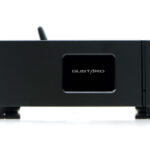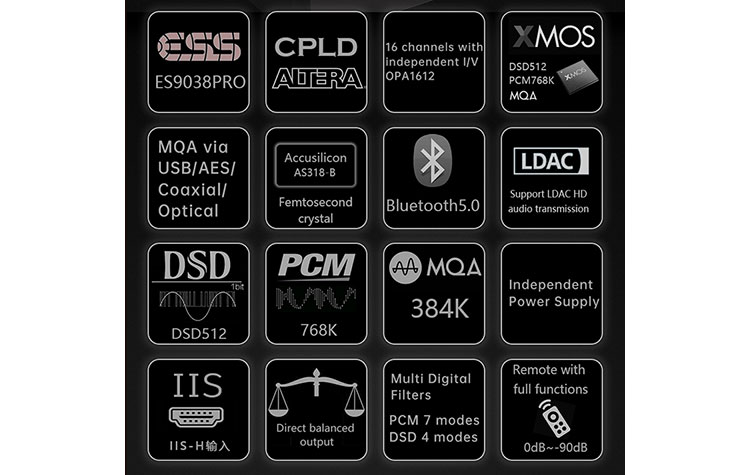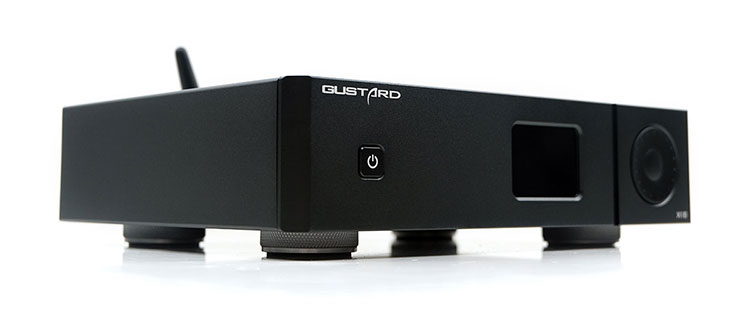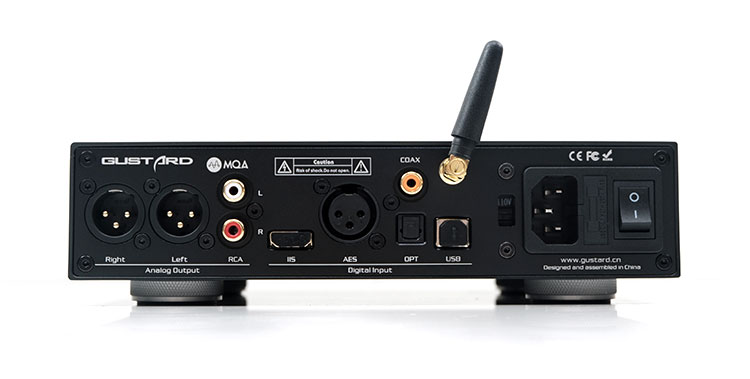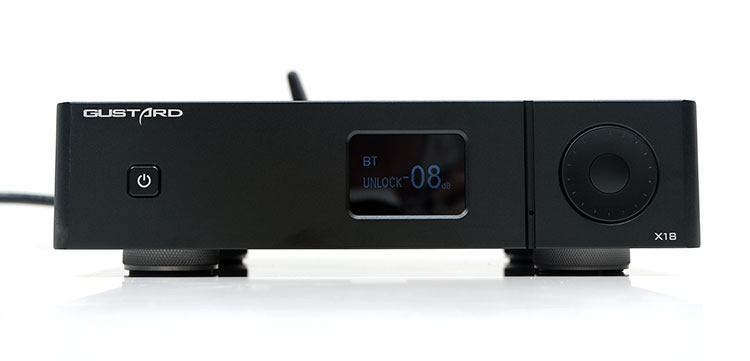Today we review the Gustard X18, which is a compact MQA-capable desktop DAC using the flagship ESS Sabre ES9038PRO chipset. It is priced at $749.
Disclaimer: This was sent to us as a sample for our honest opinion. Headfonics is an independent website with no affiliate links or services. We thank Aoshida Audio and Gustard for this opportunity.
To learn more about Gustard products previously featured on Headfonics you can click here.
Note that this article follows our latest scoring guidelines which you can read up on here.
Almost exactly a year ago we reviewed the rather impressive-sounding X16 DAC from Gustard. This was a solid piece of kit with plenty of features and a transparent detailed sound signature that paired really well with a wide range of amps.
Well, now we are back with the new X18 DAC and you could be forgiven for having to take a second look because on the outside they are very much from the same design language.
However, internally the X18 DAC has had some upgrades including a new flagship-level delta-sigma DAC with a beefed-up I/V conversion array to match, as well as an improved CLPD chipset for clock management. There also seem to be a few nuanced but useful external updates via customer feedback over the last year from the X16.
One other big change is the price. This is now a $749 value DAC as opposed to the X16’s $499 price point. This places it closer to the likes of some of the good quality entry-level R2R DACs and possibly even the Chord Qutest.
Tech Highlights
DAC
Out goes the X16’s dual 32BIT 2-channel ES9068AS chipset, with the X18 instead using a single ES9038PRO delta-sigma implementation. That is a shift from a quad-channel design (2×2) to an ESS flagship-channel DAC with all 8 channels in parallel utilized I believe from looking at the schematics and pitch.
To get that 8-channel performing Gustard has beefed up the independent OPA1612A I/V conversion count from the X16 to 8 in total (dual channel) and also changed the clock management on the digital bridge from an Altera MAX II to a MAX V CPLD. The Altera MAX V is also supported by a dual Accusilicon Femtosecond Crystal Oscillator for jitter control.
One of the big features of the V is its lower core voltage rating compared to the MAX II. This helps reduce the X18’s power consumption as well as increase clock frequency. I suspect the switch to the MAX V also helps lower the X18 material costs as it is cheaper to procure than the MAX II which has been gradually phased out over the last year or so.
Decoding
Since both share the same XMOS XU216 USB interface, the decoding on the X18 is unchanged from the X16. That is a good thing since it’s pretty much as good as it gets at up to DSD512 and PCM 32BIt/768kHz.
The X18 also comes with the same Qualcomm CSR8675 BT chipset from the X16 so you will also get up to LDAC 24BIT/96kHz wireless decoding in receiving mode. MQA rendering and unfolding is up to 8X or a top-tier of 384kHz upsampling.
You also get I²S decoding up to DSD512 and PCM 768kHz as well as SPDIF up to DSD64 over DoP and PCM 24BIT/192Khz. Note that USB does the full MQA decoding sequence, with IIS and SPDIF rendering only.
As with the X16, the X18 also includes an option to control oversampling with NOS built into the menu system as well as 3 different types of digital filters. We actually preferred keeping NOS turned off though on the X16 version. The non-NOS performance had a slightly improved treble presence whereas NOS sounded a bit flat and less distinct.
Pre-Amp
The Gustard X18 DAC will also give you pre-amping functionality with both fixed and variable voltage modes via single-ended and balanced 3-pin XLR outputs.
It also seems Gustard has taken this opportunity to revise the X16 voltage output levels and increased them going from 2V to 2.5V SE and from 4V to 5.5V balanced which should add a bit more grunt to connected analog amps’ dynamic range performance.
On paper, the new DAC implementation does suggest Gustard has managed to further refine the X16’s performance numbers. The potential dynamic range seems to have improved by around 2dB, though crosstalk and IMD numbers are unchanged at -130dB and <0.0004% @-1dBfs.
Design
Dimensions
To be honest, the X18 DAC design is more of the same with almost identical measurements to the X16 at 22 x 5 x 17cm and 2.5Kg weight. That means a pleasingly compact and stackable CNC’ed aluminum box and something that is never going to take up a huge space on your desktop or HiFi rack.
The dimensions should be a plus for existing Gustard H16 amp owners as they should stack quite neatly on top of each other. I have also been finding it a really neat DAC solution to the more expensive Ferrum Audio OOR/HYPSOS amp and PSU combo though with the recent release of their ERCO DAC it is back out on its own again feeding some other amplifiers.
Design Language
The design language is very minimalist, clean, and low-profile with smooth cornering and comes in two finishes, black, and silver. Personally, I think black looks much more appealing but beauty is always in the eye of the beholder.
Gustard has not tweaked the original X16 design too much so you get those familiar partition-like lines to the right separating an almost flush but grippy multifunction dial. The center of the dial is the function button for menu operation so together they form a multifunction control system for both preamp volume control and menu operation.
The slightly off-center small black and white OLED display panel on the front panel has a similar positioning as are the types of inputs and outputs which are all housed on the rear panel.
Stylistically, the X18 DAC OLED display uses a bigger font and an off-white tone which improves the legibility over the tiny font on the X16 screen as well as reducing potential eye strain.
The addition of a front panel power button on the X18 is new though the main power circuit is still activated by a fused 1/0 flick switch to the rear much like the X16. Gone is the X16 multi-circle machining on the far left front panel of the X18 which I honestly kind of liked as it added a bit of character to the minimalist styling.
I/O
To the rear, the X18 offers a fairly comprehensive set of digital and analog I/O. That includes both balanced and single-ended 3-pin XLR and RCA outputs for the analog output and optical, coaxial, and USB for your traditional digital inputs.
The X18 also offers the same I²S connection as the X16 for linking to compatible devices such as additional streamers as well as an AES 3-pin XLR input socket. Do note that I²S standards vary so compatibility is not assured as was the case with the X16’s version which did not gel at all with our Cayin iDAP-6 streamer.
The last socket is for the BT antenna beside the PSU and as you can see it is a good bit shorter than the original X16 antennae. It is still rotational so you switch it left or right in either direction to best suit your setup though height wise it should not take up anywhere near the same space as the longer X16 antennae.
One final note is more superficial with a slight change in I/O physical placement compared to the X16. The coaxial input is now above the optical which in turn has moved away from the analog section and beside the USB input. Gustard has also very kindly provided some dust stoppers for the I²S and USB ports.
Controls
You can control the X18 either through a supplied remote control or manually from the multi-function dial on the unit. All the user-adjustable options are available on the OLED display including the decoding rate, input stage, and volume levels if using the X18 as a pre-amp.
The menu system itself offers 5 options to adjust including 3 PCM filters, NOS or Non-NOS mode, always on BT if you prefer, and a phase invert option. You have two environmental controls, the first of which is a timed auto-off for the display selector and the second the overall brightness of the screen itself.
Remote Control
The Gustard X18 DAC uses the exact same remote control as the X16 and like the previous version, you can consider it more of a control suite that goes beyond the DAC to also operate some of Gustard’s amp and streaming units. You have the ability to switch between them by pressing a DAC, amp, or streamer button at the bottom of the remote control.
All other options can be accessed via the remote control including menu navigation/selection, (directional and play style button pad), as well as volume control. You can also switch between your input options with the navigational up button without having to directly access the menu.
One small warning, both the X18 and the X16 remotes are coded the same meaning one remote can control both. If in the unlikely event you are using both units at the same time you could inadvertently operate the wrong DAC from the remote.
Wireless Performance
Pairing
On its own, (i.e. without an X16 sitting underneath it), the X16 DAC BT connection is incredibly easy to set up. Simply press the central button on the rotary dial to get to the BT mode and scan on your transmitting source to find it and hit the pair button. Both devices should pair immediately.
In the X18 menu, you can also choose between a select mode and an always-on mode for BT. That means BT will only turn on when you select the BT mode, otherwise, it is off on all other modes. With always-on, it stays visible to other devices no matter what mode you choose.
A few notes from my experience with the X18 DAC pairing functionality though. For one, it does not seem to be multi-point with my MacBook blocking my phone connection and vice versa. I had the same experience also with the latest DX240 DAP not being able to see the Gustard BT pairing tag when a phone was already connected to it.
The second note, one less likely to occur is when you have an active X16 and X18 DAC on BT at the same time. Both have the same ‘Gustard BT’ label which will confuse owners of both. I would have added X16 and X18 to the end of the transmitted labels to create easily understood unique identifiers.
Stability & Range
The range and stability within that range from the transmitting source to the X18 DAC is good but not quite as strong as the X16 when positioned in the same spot using LDAC from a Samsung Z Flip 3 smartphone.
I can get to 10 meters easily with one wall in between on the X16 but by the time I get to 10m from the X18 DAC I get a little bit of signal drop out and stutter.
My first instinct was to blame it on the new stubby antennae being shorter and perhaps weaker than the longer X16 version but after changing the antennae around the result was the same. This might be an internal layout change reducing transmission strength or perhaps a lower transmission power setting to reduce the potential for EMI.
Latency
The X18 DAC’s BT latency performance is excellent, even when dropping down to aptX on Windows 10, (Acer Nitro 5). Using VLC, and a few media tracks with high bit rates there was never any desire to tweak the audio to video synchronization.
With streaming content on aptX Windows 10 such as Netflix and YouTube, the lag was slightly more noticeable but the performance overall was on par with the X16’s equivalent BT connection. I got much better performance using the X18 with LDAC from portable sources with both Netflix and YouTube audio and video sync very tight with no noticeable lag.
Click on page 2 below for sound impressions and pairings
Click on page 3 below for select comparisons


